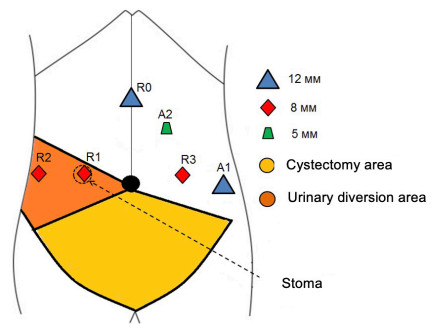Robot-assisted radical cystectomy for bladder cancer: single-center experience
doi: 10.2478/fzm-2022-0006
-
Abstract:
Objective Radical cystectomy remains the most effective treatment for patients with localized, invasive bladder cancer and recurrent noninvasive disease. Recently some surgeons have begun to describe outcomes associated with less invasive surgical approaches to this disease, such as laparoscopic or robotic assisted techniques. We report our maturing experience with 100 consecutive cases of robotic assisted laparoscopic radical cystectomy regarding perioperative results, pathological outcomes, and surgical complications. Methods A total of 100 consecutive patients (73 male and 27 female) underwent robotic radical cystectomy with intracorporeal urinary diversion at our institution from February 2018 to February 2021 for clinically localized bladder cancer. Outcome measures evaluated included operative variables, hospital recovery, pathological outcomes, and complication rate. Results The mean age of this cohort was 60.4 years (range 38 to 82). Ninety-five patients underwent ileal conduit diversion, 5 received a neobladder). The mean operating room time for all patients was 184 min (min time was 160 min) and mean surgical blood loss was 286 ml. On surgical pathology, 2% of the cases were pT1, 35% were pT2, 51+12% were pT3/T4 disease and 17% were node positive. The mean number of lymph nodes removed was 16 (range 10 to 40). In no case was there a positive surgical margin. The mean days to flatus were 2.6, bowel movement 2.8 and discharge home 8.2. There were 21 postoperative complications in 20 patients with 4% having a major complication (Clavien grade 3 or higher) and 15% being readmitted within 30 days after surgery. At a mean follow-up of 12 months 3 patients had disease recurrence and died 4 of disease. Conclusions We report a relatively large cohort and maturing experience with robotic radical cystectomy for the treatment of bladder cancer, providing acceptable surgical and pathological outcomes. These results support continued efforts to refine the surgical management of muscle-invasive bladder cancer. -
Table 1. Patient characteristics
Variable RARC(n=100) Age, year, mean 60, 4(38-82) BMI, kg/m2, mean 29.5(3.9) Male, n(%) 83(83) ASA grade, n(%) ASA1 10(10) ASA2 58(58) ASA3 32(32) ASA = American Society of Anesthesiologists; BMI = body mass index Table 2. Oncological characteristics
RARC 100 patients Clinical Stage сT1 4 сT2 38 сT3 49 сT4 9 Tumor grade (biopsy) G1 4 G2 44 G3 52 Table 3. Patient's characteristics
Variable Number of patients(n=100) Sex Male/Female 73/27 Urinary diversion type, n(%) Ileal conduit(Bricker) 15(26.34%) Neobladder(Studer) 17(29.8%) Mean operative time, min(±SD) 184±86 Mean estimated blood loss, mL(±SD) 286±91 Mean hospitalization time, days(±SD) 8.2±5.1 Mean removal drain time, days(±SD) 7.4±3.4 Mean follow-up, months(±SD) 12.1±3.2 Table 4. Pathological outcomes
Stages RARC 100 Clinical stage pT1 2 pT2 35 pT3 51 pT4 12 Pathological stage pG1 1 pG2 54 pG3 45 Lymph node yield N0 87 N1 12 N2 5 Table 5. 30 day complications
Complications n RARC 100 Anemia 5 Blood transfusion Lymphocele 2 Observation Ureteroileal anastomosis leak 4 Nephrostomy Wound infection - Ileoileal anastomosis leak 2 Laparotomy. Ileostomy. Ureterocutaneostomy Urinary infection 3 parenteral antibiotic treatment Ileus 4 parenteral serotonin receptor agonists Deep vein thrombosis 1 Anticoagulant treatment Table 6. 90 day complications
Complications n Management Hydronephrosis/Ureteroileal anastomosis 2 Nephrostomy stricture Urinary infection 5 Parenteral antibiotic treatment -
[1] International Agency for Research on Cancer. Global Cancer Observatory. https://gco.iarc.fr/. Accessed on October 12, 2020. [2] Shabsigh A, Korets R, Vora K C, et al. Defining early morbidity of radical cystectomy for patients with bladder cancer using a standardized reporting methodology. Eur Urol, 2009; 55(1): 164-174. doi: 10.1016/j.eururo.2008.07.031 [3] Lowrance W T, Rumohr J A, Chang S S, et al. Contemporary open radical cystectomy: analysis of perioperative outcomes. J Urol, 2008; 179(4): 1313-1318. doi: 10.1016/j.juro.2007.11.084 [4] Ukimura O, Moinzadeh A, Gill I S. Laparoscopic radical cystectomy and urinary diversion. Curr Urol Rep, 2005; 6(2): 118-121. doi: 10.1007/s11934-005-0078-2 [5] Bochner B H, Sjoberg D D, Laudone V P. Memorial sloan kettering cancer center bladder cancer surgical trials group. A randomized trial of robot-assisted laparoscopic radical cystectomy. N Engl J Med, 2014; 371(4): 389-390. doi: 10.1056/NEJMc1405213 [6] Khan M S, Gan C, Ahmed K, et al. A single-centre early phase randomised controlled three-arm trial of open, robotic, and laparoscopic radical cystectomy (CORAL). Eur Urol, 2016; 69(4): 613-621. doi: 10.1016/j.eururo.2015.07.038 [7] Novara G, Catto J W, Wilson T, et al. Systematic review and cumulative analysis of perioperative outcomes and complications after robot-assisted radical cystectomy. Eur Urol, 2015; 67(3): 376-401. doi: 10.1016/j.eururo.2014.12.007 [8] Guliev B G, Bolokotov R R. Robot-assisted and open radical cystectomy: comparative analysis of results. Urology Herald, 2020; 8(1): 59-68. (In Russ. ) doi: 10.21886/2308-6424-2020-8-1-59-68 [9] Challacombe B J, Bochner B H, Dasgupta P, et al. The role of laparoscopic and robotic cystectomy in the management of muscle-invasive bladder cancer with special emphasis on cancer control and complications. Eur Urol, 2011; 60(4): 767-775. doi: 10.1016/j.eururo.2011.05.012 [10] Gill I, Cacciamani G E. The changing face of urologic oncologic surgery from 2000-2018 (63141 patients)-impact of robotics. Eur Urol, 2019; 18(1): e656-e657. doi: 10.1016/S1569-9056(19)30485-3 [11] Mistretta F A, Luzzago S, Musi G, et al. Minimally invasive versus open radical cystectomy: long term oncologic outcomes compared. Transl Androl Urol, 2020; 9(3): 1006-1008. doi: 10.21037/tau-2020-03 [12] Feng D, Li A, Hu X, et al. Comparative effectiveness of open, laparoscopic and robot-assisted radical cystectomy for bladder cancer: a systematic review and network meta-analysis. Minerva Urol Nefrol, 2020; 72(3): 251-264. [13] Fonseka T, Ahmed K, Froghi S, et al. Comparing robotic, laparoscopic and open cystectomy: a systematic review and meta-analysis. Arch Ital Urol Androl, 2015; 87(1): 41-48. doi: 10.4081/aiua.2015.1.41 [14] Khan M S, Omar K, Ahmed K, et al. Long-term Oncological References Outcomes from an Early Phase Randomised Controlled Three-arm Trial of Open, Robotic, and Laparoscopic Radical Cystectomy (CORAL). Eur Urol, 2020; 77(1): 110-118. doi: 10.1016/j.eururo.2019.10.027 [15] Kim T H, Sung H H, Jeon H G, et al. Oncological outcomes in patients treated with radical cystectomy for bladder cancer: comparison between open, laparoscopic, and robot-assisted approaches. J Endourol, 2016; 30(7): 783-791. doi: 10.1089/end.2015.0652 [16] Hussein A A, May P R, Jing Z, et al. Outcomes of intracorporeal urinary diversion after robot-assisted radical cystectomy: results from the International Robotic Cystectomy Consortium. J Urol, 2018; 199(5): 1302-1311. doi: 10.1016/j.juro.2017.12.045 [17] Porreca A, Bianchi F M, Romagnoli D, et al. Robot-assisted radical cystectomy with totally intracorporeal urinary diversion: surgical and early functional outcomes through the learning curve in a single high-volume center. J Robot Surg, 2020, 14(1): 261-269. [18] Khan M S, Gan C, Ahmed K, et al. A single-centre early phase randomised controlled three-arm trial of open, robotic, and laparoscopic radical cystectomy (CORAL). Eur Urol, 2016; 69(4): 613-621. doi: 10.1016/j.eururo.2015.07.038 [19] Porreca A, Chessa F, Romagnoli D, et al. Robot assisted radical cystectomy with totally intracorporeal urinary diversion: initial, single-surgeon's experience after a modified modular training. Minerva Urol Nefrol, 2018; 70(2): 193–201. [20] Richards K A, Kader K, Pettus J A, et al. Does initial learning curve compromise outcomes for robot-assisted radical cystectomy? A critical evaluation of the first 60 cases while establishing a robotics program. J Endourol, 2011; 25(9): 1553-1558. doi: 10.1089/end.2010.0630 [21] Sim A, Balbay M D, Todenhöfer T, et al. Robot–assisted radical cystectomy and intracorporeal urinary diversion–safe and reproducible? Cent Eur J Urol, 2015; 68(1): 18-23. [22] Kader A K, Richards K A, Krane L S, et al. Robot-assisted laparoscopic vs open radical cystectomy: comparison of complications and perioperative oncological outcomes in 200 patients. BJU Int, 2013; 112: e290–e294. [23] Canda A E, Atmaca A F, Altinova S, et al. Robot-assisted nerve-sparing radical cystectomy with bilateral extended pelvic lymph node dissection (PLND) and intracorporeal urinary diversion for bladder cancer: initial experience in 27 cases. BJU Int, 2012; 110(3): 434–444. doi: 10.1111/j.1464-410X.2011.10794.x [24] Schumacher M C, Jonsson M N, Hosseini A, et al. Surgery-related complications of robot-assisted radical cystectomy with intracorporeal urinary diversion. Urology, 2011; 77(4): 871-876. doi: 10.1016/j.urology.2010.11.035 -


 投稿系统
投稿系统


 下载:
下载:








